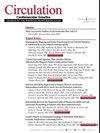性别决定心肌细胞的伸展和放松。
引用次数: 3
摘要
本文章由计算机程序翻译,如有差异,请以英文原文为准。
Sex Determines Cardiac Myocyte Stretch and Relaxation.
Trexler et al1 show for the first time that biological sex differences in isolated rat cardiomyocytes and myofibrils affect myocyte function. In addition, they discovered sex-specific cardiomyocyte gene expression profiles, like the protein kinase A pathway, that could provide insight into sex differences in cardiovascular diseases (CVDs). This study reports sex differences in gene profiles of isolated cardiomyocytes using high-quality RNAseq data, which allows a more detailed look at gene differences than previously published gene expression studies that typically used microarray of whole hearts (a combination of myocytes, fibroblasts, endothelial, and resident immune cells, for example).2,3 A major finding of Trexler et al1 is that healthy female rats have increased fractional shortening in both whole hearts and in paced cardiomyocytes. Female cardiac myocytes and myofibrils also take longer to relax after contraction, which may contribute to cardiac dysfunction in women after cardiac injury or disease.
See Article by Trexler et al
CVD is the leading cause of death in men and women worldwide.4 Before age 60, men are at an increased risk of death because of heart failure, whereas women develop some forms of heart disease, like stroke and hypertension, more frequently after menopause.4,5 Historically, women have been underrepresented in cardiovascular clinical trials.6 This led to the National Institutes of Health requirement to include women in clinical trials with the unexpected outcome that the data were in most cases not being analyzed according to sex. Controlling for sex or examining only one sex is not sufficient to understand the reason for sex (biological) and gender (social) differences in CVD and other chronic diseases.7 …
求助全文
通过发布文献求助,成功后即可免费获取论文全文。
去求助
来源期刊

Circulation: Cardiovascular Genetics
CARDIAC & CARDIOVASCULAR SYSTEMS-GENETICS & HEREDITY
自引率
0.00%
发文量
0
审稿时长
6-12 weeks
期刊介绍:
Circulation: Genomic and Precision Medicine considers all types of original research articles, including studies conducted in human subjects, laboratory animals, in vitro, and in silico. Articles may include investigations of: clinical genetics as applied to the diagnosis and management of monogenic or oligogenic cardiovascular disorders; the molecular basis of complex cardiovascular disorders, including genome-wide association studies, exome and genome sequencing-based association studies, coding variant association studies, genetic linkage studies, epigenomics, transcriptomics, proteomics, metabolomics, and metagenomics; integration of electronic health record data or patient-generated data with any of the aforementioned approaches, including phenome-wide association studies, or with environmental or lifestyle factors; pharmacogenomics; regulation of gene expression; gene therapy and therapeutic genomic editing; systems biology approaches to the diagnosis and management of cardiovascular disorders; novel methods to perform any of the aforementioned studies; and novel applications of precision medicine. Above all, we seek studies with relevance to human cardiovascular biology and disease.
 求助内容:
求助内容: 应助结果提醒方式:
应助结果提醒方式:


